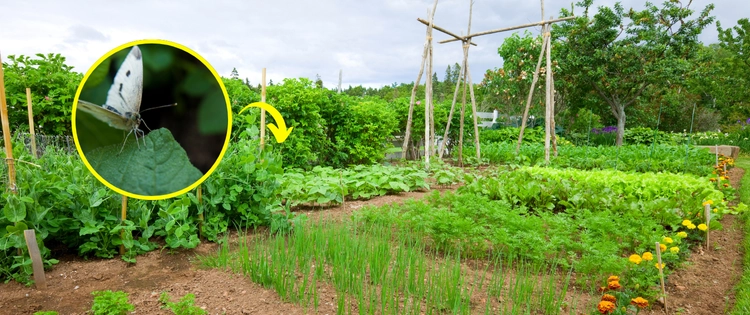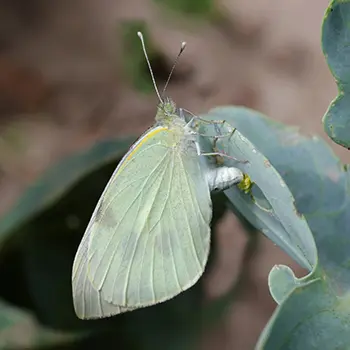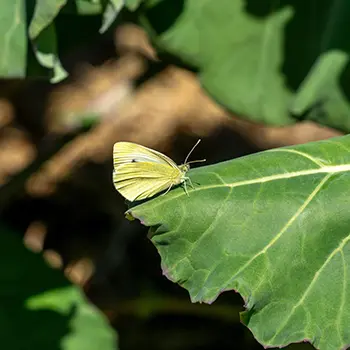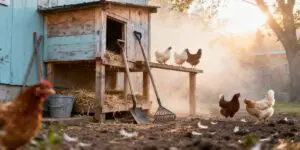Imagine, if you will, you’re sitting in your garden and enjoying the warm summer breeze. Your plants are growing so quickly that you can almost hear their stems stretching, and their leaves unfurling. It’s incredible, knowing that you did this. This beautiful place is because of your hard work and your education in how to grow such pretty plants.
And then a little white butterfly flutters past.
Oh, no.
This Vile Betrayer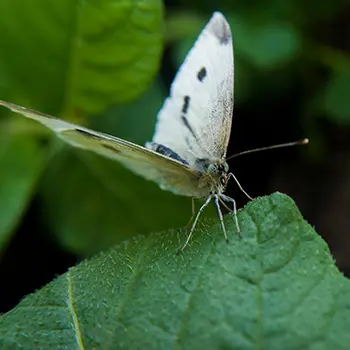
Though sometimes considered a butterfly at first sight, this is actually a moth. The White Cabbage Moth is bad news for all of your brassicas, including the vast majority of leafy greens, but especially for your cabbages.
Yes, yes. Oh, no. Your cabbages. Some of our younger readers are grinning because there’s an A: TLA reference. I know I am.
But back to the serious stuff, this absolutely gorgeous little moth will destroy your cabbages and anything else green they can get their little mitts on… as larvae. Unfortunately, these moths will breed like rabbits when conditions are right. The question is, what are you doing wrong to encourage these little monsters to show up in the first place?
What’s Going Wrong
Ultimately, the only thing you may be doing wrong is simply having cabbage. While cabbage moths (as the name suggests) are deeply in love with your cabbage and other brassica plants, that often isn’t enough to start a full-blown invasion. No, most of the time they’re attracted to abundant moisture settling around the roots of your plants.
If you suddenly see cabbage moths flitting around your garden, more likely than not you’re overwatering. Check the top 1/2″ of soil and see if your fingers come away wet. Damp is perfectly fine if you’ve watered within the past 12 hours. After all, leafy greens like most brassicas tend to be pretty heavy in their water needs and the heat of summer is certainly here right now.
If your fingers come away sopping wet, there’s your problem.
Not overwatering? Let’s talk about some ways to dismiss these hungry bugs.
How To Stop It
If you have an overwatering problem, that’s very simple to fix: stop overwatering. We realize that this is common sense advice, and with some leafy greens, it may not be that simple. If they’re used to a profuse amount of water, you need to cut back slowly. So what do you do in the meantime while your plants are getting crunched and munched by invasive White Cabbage Moth larvae?
You can take your time and remove each visible larvae by hand if you can spare such an investment. It’s going to take a while, even with a small invasion of these moths. They’re prolific and they have an incredibly high hatch rate considering that their eggs are so very, very small. Side note: Don’t try to remove the eggs. You almost certainly won’t find them this time of the year. Your plants are likely too large and too hard to lift and examine within completely removing them from their roots.
Thyme and borage emit a scent that covers most brassica scents from being available to predatory insects like White Cabbage Moths and their larvae. While it’s unlikely that you’ll send the larvae themselves screaming, it’s very likely that their parents will leave the area and never return. They hate the scent of these gorgeous herbs and both are wonderful additions to most gardens.
Do take care that a significant amount of the population may be slightly allergic to borage. Get a few dried leaves and test them out near your family before you plant a large plot of them.
But, I Like Them
This is probably one of the hardest parts of gardening. Come close; I’ll admit a secret. I like them, too. I think they’re pretty moths that probably aren’t actually trying to do any damage. They just happen to do so. A small infestation of them can completely level all of your brassicas in a couple of weeks and, as I said above, they reproduce like wildfire. You aren’t going to do yourself any favors by keeping them around and once they have a substantial foothold in your garden, they can be pretty hard to get rid of.
While there are lots of commercial products that advertise getting rid of them (and do work) you may also harm local pollinators with these products. This is the last thing we want to do or advocate for; the pollinators are having a hard enough time as it is and we don’t want to make it harder.
So What Do I Do?
Okay, it’s secret time again. I put together a small patch of sacrificial cabbage that I intend to feed to the poultry at the end of its season. I place it all the way on the other side of our property from the brassicas I intend for the family to eat. I let the cabbage moths have the sacrificial plot and I sit back (far, far back) and I enjoy them throughout the season.
For prevention, I plant lemon thyme all around the family’s brassicas. It’s pretty, it works just as well as typical thyme, and we do have someone allergic to borage in the house (it’s a family pet, oddly enough) so that isn’t an option for us.
Related: Easy DIY Garden Pest Killer You Can Make At Home
Ethically, I can’t recommend allowing these moths to continue breeding, but my gardens are over a mile away from any other brassicas and their territory is only 1/2 mile or so, square. I’m not infesting anyone else and I’m careful to feed the leftover cabbages to the chickens, which kills off a large amount of the next generation of White Cabbage Moths for the next year.
Even if you love them like I do, you have to make sure that you’re strictly controlling their population.
What about you? What’s the rule in your garden for pests when you love their appearance but hate what the damage they do? Do you make a sacrificial garden for them, or are you all about getting rid of the problem?
And what is your opinion on these pretty little moths? We look forward to hearing from you in the comments section down below and, as always, Happy Gardening!
Plant These To Keep The Pests Away (Video)
If You See This Jumping Worm In Your Garden, Kill It Immediately!

